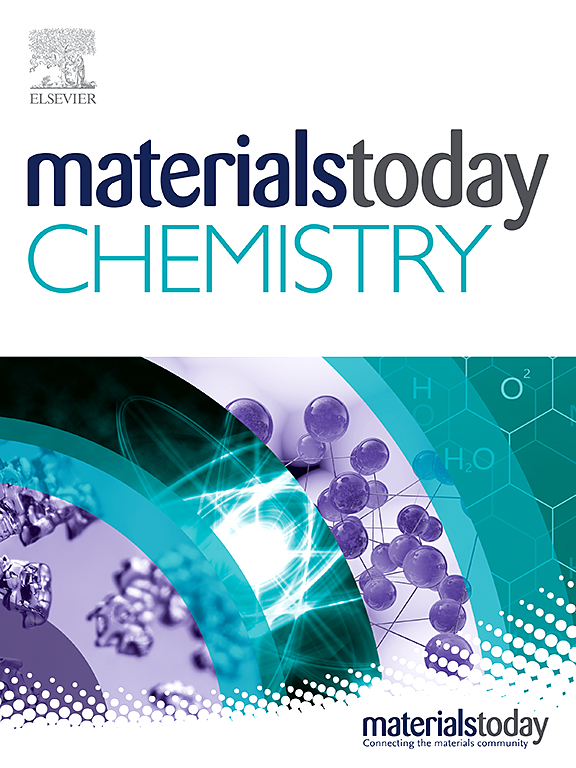Bio-functionalized conductive poly(acrylic acid):poly(3,4-Ethylenedioxythiophene)-Prussian blue hybrid transducer for biosensors and bioelectronics interfaces
IF 6.7
2区 化学
Q1 CHEMISTRY, MULTIDISCIPLINARY
引用次数: 0
Abstract
This study presents an innovative organic-inorganic hybrid transducer of poly(acrylic acid) (PAA), poly(3,4-ethylenedioxythiophene) (PEDOT) and Prussian blue (PB) nanocatalysts. The transducer demonstrated functionality conducive to enzyme conjugation and exhibited favorable electrochemical properties for biosensor signal transduction. Fabricated by a one-tube chemical redox method, the PAA:PEDOT-PB transducer showed long-term electrocatalytic and structural stability. The performance of the transducer was characterized by high transduction activity and low charge transfer resistance, particularly for HO reduction. It achieves a linear detection range from 1.0 μM to 4.0 mM, with a sensitivity of 494 ± 10 μA mM cm and a LOD of 0.34 μM. The PAA:PEDOT-PB transducer featured a high density of carboxyl groups (D = 14.64 ± 0.05 μmol cm) that promoted the immobilization of the HO-dependent oxidase enzyme lactate oxidase (LOx) with an EDC/S–NHS coupling agent. The LOx-PAA:PEDOT-PB transducer was developed for lactate biosensing. The transducer provided high LOx-enzyme affinity (K = 1.47 ± 0.05 mM), and a rapid response time (10 s) for lactate detection across a concentration range of 5.0 μM to 4.0 mM, showing a sensitivity of 223 ± 3 μA mM cm and an LOD of 1.45 μM. The LOx-PAA:PEDOT-PB transducer was integrated with a flexible screen-printed electrode, incorporating a wireless, battery-free near-field communication potentiostat module to measure lactate in artificial sweat on a skin model via smartphone. The PAA:PEDOT-PB transducer could enable connections with multiple bio-recognition molecules through polycarboxylic acid groups, providing potential avenues for the development of advanced biosensors.生物功能化导电聚(丙烯酸):聚(3,4-亚乙二氧基噻吩)-普鲁士蓝混合传感器,用于生物传感器和生物电子学接口
本研究提出了一种创新的有机-无机混合传感器,由聚(丙烯酸)(PAA)、聚(3,4-亚乙二氧基噻吩)(PEDOT)和普鲁士蓝(PB)纳米催化剂组成。这种传感器具有有利于酶连接的功能,并表现出有利于生物传感器信号传导的电化学特性。通过单管化学氧化还原法制作的 PAA:PEDOT-PB 传感器显示出长期的电催化和结构稳定性。该传感器的性能特点是高转导活性和低电荷转移电阻,尤其是在 HO 还原方面。它的线性检测范围为 1.0 μM 至 4.0 mM,灵敏度为 494 ± 10 μA mM cm,LOD 为 0.34 μM。PAA:PEDOT-PB 传感器具有高密度的羧基(D = 14.64 ± 0.05 μmol cm),可促进依赖于 HO 的氧化酶乳酸氧化酶(LOx)与 EDC/S-NHS 偶联剂的固定。开发出了用于乳酸盐生物传感的 LOx-PAA:PEDOT-PB 传感器。该传感器具有较高的 LOx 酶亲和性(K = 1.47 ± 0.05 mM)和快速响应时间(10 秒),可在 5.0 μM 至 4.0 mM 的浓度范围内检测乳酸盐,灵敏度为 223 ± 3 μA mM cm,LOD 为 1.45 μM。LOx-PAA:PEDOT-PB传感器与柔性丝网印刷电极相集成,结合了无线、免电池近场通信恒电位仪模块,可通过智能手机在皮肤模型上测量人工汗液中的乳酸盐。PAA:PEDOT-PB 传感器可通过聚羧酸基团与多种生物识别分子连接,为开发先进的生物传感器提供了潜在的途径。
本文章由计算机程序翻译,如有差异,请以英文原文为准。
求助全文
约1分钟内获得全文
求助全文
来源期刊

Materials Today Chemistry
Multiple-
CiteScore
8.90
自引率
6.80%
发文量
596
审稿时长
33 days
期刊介绍:
Materials Today Chemistry is a multi-disciplinary journal dedicated to all facets of materials chemistry.
This field represents one of the fastest-growing areas of science, involving the application of chemistry-based techniques to the study of materials. It encompasses materials synthesis and behavior, as well as the intricate relationships between material structure and properties at the atomic and molecular scale. Materials Today Chemistry serves as a high-impact platform for discussing research that propels the field forward through groundbreaking discoveries and innovative techniques.
 求助内容:
求助内容: 应助结果提醒方式:
应助结果提醒方式:


